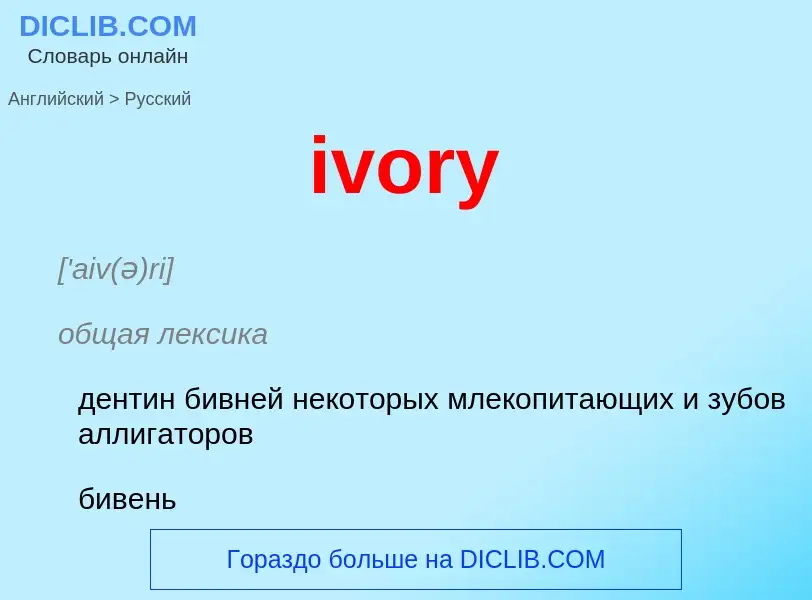Traducción y análisis de palabras por inteligencia artificial
En esta página puede obtener un análisis detallado de una palabra o frase, producido utilizando la mejor tecnología de inteligencia artificial hasta la fecha:
- cómo se usa la palabra
- frecuencia de uso
- se utiliza con más frecuencia en el habla oral o escrita
- opciones de traducción
- ejemplos de uso (varias frases con traducción)
- etimología
ivory - traducción al ruso
['aiv(ə)ri]
общая лексика
дентин бивней некоторых млекопитающих и зубов аллигаторов
бивень
клык
Смотрите также
прилагательное
общая лексика
состоящий или сделанный из слоновой кости
цвета слоновой кости
существительное
['aiv(ə)ri]
общая лексика
слоновая кость
имитация слоновой кости
бивни
клык
цвет слоновой кости
предмет
сделанный из слоновой кости
цвета слоновой кости
сленг
игральные кости
бильярдные шары
клавиши
резьба по слоновой кости
обыкн. [сл.] зубы
собирательное выражение
предметы из слоновой кости: игральные кости, бильярдные шары, клавиши
Definición
Wikipedia

Ivory is a hard, white material from the tusks (traditionally from elephants) and teeth of animals, that consists mainly of dentine, one of the physical structures of teeth and tusks. The chemical structure of the teeth and tusks of mammals is the same, regardless of the species of origin, but ivory contains structures of mineralised collagen. The trade in certain teeth and tusks other than elephant is well established and widespread; therefore, "ivory" can correctly be used to describe any mammalian teeth or tusks of commercial interest which are large enough to be carved or scrimshawed.
Besides natural ivory, ivory can also be produced synthetically, hence (unlike natural ivory) not requiring the retrieval of the material from animals. Tagua nuts can also be carved like ivory.
The trade of finished goods of ivory products has its origins in the Indus Valley. Ivory is a main product that is seen in abundance and was used for trading in Harappan civilization. Finished ivory products that were seen in Harappan sites include kohl sticks, pins, awls, hooks, toggles, combs, game pieces, dice, inlay and other personal ornaments.
Ivory has been valued since ancient times in art or manufacturing for making a range of items from ivory carvings to false teeth, piano keys, fans, and dominoes. Elephant ivory is the most important source, but ivory from mammoth, walrus, hippopotamus, sperm whale, orca, narwhal and warthog are used as well. Elk also have two ivory teeth, which are believed to be the remnants of tusks from their ancestors.
The national and international trade in natural ivory of threatened species such as African and Asian elephants is illegal. The word ivory ultimately derives from the ancient Egyptian âb, âbu ("elephant"), through the Latin ebor- or ebur.


![Cylindrical ivory casket, Siculo-Arabic, [[Hunt Museum]]. Cylindrical ivory casket, Siculo-Arabic, [[Hunt Museum]].](https://commons.wikimedia.org/wiki/Special:FilePath/Cylindrical Ivory Casket.jpg?width=200)
![An ivory [[tabernacle]] featuring the Madonna of Caress, France An ivory [[tabernacle]] featuring the Madonna of Caress, France](https://commons.wikimedia.org/wiki/Special:FilePath/Ivory tabernacle Louvre OA2587.jpg?width=200)

![A depiction of the [[Blessed Virgin Mary]] and the [[Child Jesus]] crafted in elephant ivory A depiction of the [[Blessed Virgin Mary]] and the [[Child Jesus]] crafted in elephant ivory](https://commons.wikimedia.org/wiki/Special:FilePath/Vierge a l'Enfant debout.jpg?width=200)
![The Bull Leaper, an ivory figurine from the palace of [[Knossos]], [[Crete]], 1500 BC The Bull Leaper, an ivory figurine from the palace of [[Knossos]], [[Crete]], 1500 BC](https://commons.wikimedia.org/wiki/Special:FilePath/The Bull Leaper Knossos 1500BC.jpg?width=200)
![pyxis]] with griffins attacking stags. Late 15th century BC pyxis]] with griffins attacking stags. Late 15th century BC](https://commons.wikimedia.org/wiki/Special:FilePath/AGMA Ivory Pyxis with Griffins Attacking Stags.jpg?width=200)
![A piece of carved ivory from the Pushkin Museum representing [[Christ]] blessing Emperor [[Constantine VII]]. Mid 10th century AD A piece of carved ivory from the Pushkin Museum representing [[Christ]] blessing Emperor [[Constantine VII]]. Mid 10th century AD](https://commons.wikimedia.org/wiki/Special:FilePath/Porphyrogenetus.jpg?width=200)
![Ivory cover of the [[Codex Aureus of Lorsch]], c. 810, [[Carolingian dynasty]], [[Victoria and Albert Museum]] Ivory cover of the [[Codex Aureus of Lorsch]], c. 810, [[Carolingian dynasty]], [[Victoria and Albert Museum]]](https://commons.wikimedia.org/wiki/Special:FilePath/Ivory cover of the Lorsch Gospels, c. 810, Carolingian, Victoria and Albert Museum.jpg?width=200)
![[[Pig]] tusks [[Pig]] tusks](https://commons.wikimedia.org/wiki/Special:FilePath/BigUnTusks6184w.jpg?width=200)

![''Battle of Hannibal and Scipio (Alexander's victory over Poros)'', by [[Ignaz Elhafen]], c. 1700, [[Warsaw Royal Castle]] ''Battle of Hannibal and Scipio (Alexander's victory over Poros)'', by [[Ignaz Elhafen]], c. 1700, [[Warsaw Royal Castle]]](https://commons.wikimedia.org/wiki/Special:FilePath/Elhafen Battle of Hannibal and Scipio.jpg?width=200)
![Section through the ivory tusk of a [[mammoth]] Section through the ivory tusk of a [[mammoth]]](https://commons.wikimedia.org/wiki/Special:FilePath/Mammoth ivory hg.jpg?width=200)

.jpg?width=200)
![The ''[[Morgan Casket]]'', an 11th-century ivory casket attributed to Southern Italy, currently in the collection of the [[Metropolitan Museum of Art]] The ''[[Morgan Casket]]'', an 11th-century ivory casket attributed to Southern Italy, currently in the collection of the [[Metropolitan Museum of Art]]](https://commons.wikimedia.org/wiki/Special:FilePath/Morgan Casket MET DP100742.jpg?width=200)
![A cubical ivory bead or game piece from the collections of the [[Hunt Museum]] A cubical ivory bead or game piece from the collections of the [[Hunt Museum]]](https://commons.wikimedia.org/wiki/Special:FilePath/Ivory bead A.jpg?width=200)
![Murshidabad]], [[India]] Murshidabad]], [[India]]](https://commons.wikimedia.org/wiki/Special:FilePath/Royal Peacock Barge LACMA M.82.154.jpg?width=200)
![Ivory workers in [[Calcutta]], c. 1903 Ivory workers in [[Calcutta]], c. 1903](https://commons.wikimedia.org/wiki/Special:FilePath/Ivory workers in Calcutta (c. 1903).jpg?width=200)
